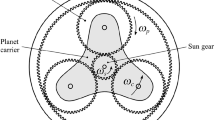Abstract
The requirement for higher energy density transmissions (lower weight) in helicopters has led to the development of the split torque gearbox (STG) to replace the traditional planetary gearbox by the drive train designer. This may pose a challenge for the current gear analysis methods used in health and usage monitoring systems (HUMS). Gear analysis uses time synchronous averages to separates in frequency gears that are physically close to a sensor. The effect of a large number of synchronous components (gears or bearing) in close proximity may significantly reduce the fault signal (reduce signal to noise ratio) and therefore reduce the effectiveness of current gear analysis algorithms. In this paper, quantification of condition indicator performance on a split torque gearbox is reported. The vibration signatures are processed through a number of gear analysis algorithms to quantify the gear fault performance. The performance metric is separability.
Similar content being viewed by others
References
Combet F., Gelman L. (2007) An automated methodology for performing time synchronous averaging of a gearbox signal without speed sensor. Mechanical systems and signal processing 21(6): 2590–2606
Decker, H. J. (2003). Crack detection for aerospace quality spur gears. NASA TM-2003021220 REV 1.
Gmirya, Y. (2008). Split torque gearbox for rotor wing aircraft with translational thrust system. USPTO, 7,413,142, August 19.
Huang N.E., Steven S.Z., Long R., Manlic W. (1998) The empirical mode decomposition and the Hilbert spectrum for nonlinear and non-stationary time series analysis. Proceeding Royal Society of London A 454(1971): 903–995
Kaewkongka T., Au Y.H.J., Rakowski R.T., Jones B.E. (2003) A comparative study of short time fourier transform for bearing condition monitoring. International Journal of Comadem 6: 41–48
Kim B.S., Lee S.H., Lee M.G., Ni J., Song J.Y., Lee C.W. (2007) A comparative study on damage detection in speed-up and coast-down process of grinding spindle-typed rotor-bearing system. Journal of Materials Processing Technology 187: 30–36
Krantz, T. (1995). Vibration analysis of a split path gearbox. NASA technical memorandum 106875, AIAA-95-3048.
Krantz, T. (1996). Code to optimize load sharing of split-torque transmissions applied to the comanche helicopter. grc.nasa.gov/WWW/ RT/RT1995/2000/2730k.
Liu B., Riemenschneider S., Xu Y. (2006) Gearbox fault diagnosis using empirical mode decomposition and Hilbert spectrum. Mechanical Systems and Signals Processing 20: 718–734
Manolakis D., Ingle V., Kogon S. (2000) Statistical and adaptive signal processing. McGraw-Hill, New York, NY
Wackerly D., Mendenhall W., Scheaffer R. (1996) Mathematical statistics with applications. Belmont CA, Wadsworth Publishing Co., p 441
Wemhoff, E., Chin, H., & Begin, M. (2007). Gearbox diagnostics development using dynamic modeling. American Helicopter Society 63th Annual Forum.
White, G. (1982). Split torque transmission. USPTO, 4,489,625, November 23.
Author information
Authors and Affiliations
Corresponding author
Rights and permissions
About this article
Cite this article
Bechhoefer, E., Li, R. & He, D. Quantification of condition indicator performance on a split torque gearbox. J Intell Manuf 23, 213–220 (2012). https://doi.org/10.1007/s10845-009-0346-y
Received:
Accepted:
Published:
Issue Date:
DOI: https://doi.org/10.1007/s10845-009-0346-y




